Romantic Winery Destinations In Sebastopol - Sebastopol's Best Wine Trails
Wine tasting is an art that combines sensory experience with an appreciation for the nuances of different varietals. How to judge flavors in winery wine tasting classes is pivotal to grasping the complexities of wine.
Partaking in a wine tasting entails more than simply sipping and savoring. It requires a centered strategy to identify aromas and flavors that every wine presents. As you start, observe the wine's look, noting its colour and clarity. These visible cues usually suggest a wine’s age, grape selection, and even potential flavor profiles.
The subsequent step in the tasting process is to swirl the wine in your glass. This action releases aromatic compounds that are vital for analysis. Lean in and take a second to inhale deeply; the aromas can vary from floral and fruity to spicy and earthy. The nostril of the wine is simply as necessary because the palate, and recognizing scents performs a significant role in understanding the general experience.
When taking your first sip, allow the wine to maneuver across your palate - Small Batch Wineries In Sonoma Valley. Discover the preliminary flavors that present themselves. Is the wine fruity, floral, or maybe herbaceous? This initial taste gives insight into what the wine is prone to categorical as you continue to evaluate it. The mouthfeel additionally contributes to the overall flavor experience; it could be silky, tannic, and even effervescent.
Wineries Offering Private Events - Sonoma Wineries With Vineyard Views
As you continue tasting, take note of the wine’s steadiness. A well-balanced wine will harmonize acidity, sweetness, and tannins. If one part overwhelms the others, it'd point out a less fascinating high quality. Evaluating stability might help you identify how properly the wine might pair with food.
Transitioning to the end, contemplate how the flavors evolve because the wine lingers in your palate. A long, pleasant finish can indicate a high-quality wine, while a short or abrupt end may suggest otherwise. Mirror on whether the flavors remain consistent or if new notes emerge as the wine settles. This progression can reveal complexities and intricacies that may not have been obvious within the initial tasting.
Temperature can also be a vital consider evaluating wine flavors. Totally Different types of wine are optimally loved at specific temperatures. White wines typically shine when chilled, whereas purple wines typically carry out best at room temperature. When tasting, make sure the wine is at the acceptable temperature to fully recognize its character.
Wineries Providing Guided Vineyard Walks - Top Wineries To Visit In Sebastopol
Pairing food with wine can significantly improve the tasting experience. Foods can influence the perception of flavors in wine, either highlighting sure traits or diminishing them. When evaluating flavors, contemplate how the wine interacts with different foods, noticing which flavors are amplified or muted (Wineries With Artisan Chocolate Pairings In Sonoma).

Contemplate the influence of terroir as you interact in a winery tasting. Terroir encompasses the unique environmental components that affect grape growing, including soil composition, local weather, and geography. Understanding a wine's terroir can present perception into its flavors and aromas, fostering a deeper appreciation for the alternatives made during its cultivation and manufacturing.
Education plays a elementary function in enhancing one's capacity to judge wine flavors. Learning about grape varieties, wine areas, and production methods can pave the click now way in which for extra informed judgments throughout tastings. Moreover, attending workshops or classes can refine sensory skills and expand your flavor vocabulary, enabling you to articulate tasting notes extra successfully.

Finally, it's essential to do not forget that evaluating wine flavors is a extremely personal experience. Individual preferences and perceptions will invariably shape one’s tasting journey. Enjoyment must be at the forefront, with the analysis process performing as a device to enhance understanding and appreciation somewhat than create rigid pointers.
Best Wineries For Wine Tasting In Sonoma - Vineyards Near Sebastopol
In conclusion, mastering tips on how to evaluate flavors in winery wine tasting sessions involves a combination of sensory engagement, information, and practice. By learning to identify aromas, assess the stability, and respect the intricacies of flavor, wine enthusiasts can deepen their connection to each bottle they encounter. As with any art kind, the extra one immerses themselves within the experience, the extra they'll uncover and benefit from the huge world of wine.
- Start by observing the wine's color and readability, as these visible parts can trace at its flavor profile and getting older potential.
- Swirl the wine gently in your glass; this releases fragrant compounds, permitting you to better identify the complicated scents associated with the wine.
- Take a deep inhale before tasting, focusing on both major and secondary aromas to assemble insights on fruits, spices, and other nuances.
- When tasting, enable the wine to coat your palate; note the preliminary flavors, the mid-palate complexity, and the finish as these stages can present totally different flavor highlights.
- Pay consideration to texture and mouthfeel, as features corresponding to tannin levels, acidity, and sweetness contribute considerably to the overall tasting experience.
- Examine flavors towards commonplace wine characteristics; for pink wines, contemplate berry notes, oak influence, and herbal tones, whereas whites might include citrus, stone fruits, and floral hints.
- Take notes through the tasting session to track your impressions, serving to you to recollect and consider the different wines sampled.
- Focus On your findings with fellow tasters or winery staff, as sharing insights can improve understanding and appreciation of particular person flavors.
- Allow time for the wine to breathe; typically, flavors evolve and reveal new dimensions after being exposed to air.
- Experiment with food pairings through the tasting as they will dramatically alter how flavors are perceived, influencing general enjoyment.undefinedWhat should I search for when evaluating the aroma of wine throughout a tasting?
Start by swirling the wine in your glass to release its aromas. Convey the glass to your nose and take a deep breath. Pay attention to the first scents you detect, as these are often essentially the most distinguished. Look for fruit, floral, herbal, or earthy notes and attempt to determine specific traits, which will deepen your understanding of the wine's complexity.
Vintage Wine Tasting Experiences In Sebastopol - Sonoma Wine Tasting Recommendations

How can I distinguish between different flavor profiles in wine?
Perceive that flavor profiles are sometimes categorized as fruit, floral, herbaceous, spicy, or mineral. Take small sips and allow the wine to coat your palate. Notice the primary flavors that emerge first and the refined notes that follow. This layering is essential in distinguishing the wine's traits and will assist you to appreciate its distinctive profile.
Intimate Wine Tasting Experiences In Sonoma - Top-Rated Wineries In Sebastopol
What is the significance of the wine's texture in a tasting?

The texture of the wine, also known as mouthfeel, performs a crucial role in how we perceive flavors. Pay attention as to if the wine feels clean, creamy, or gritty. The body of the wine (light, medium, or full) can enhance or contrast with flavors, offering a more rounded experience during tasting.
How do I assess the stability of flavors in wine?
Stability in wine refers back to the harmony between acidity, sweetness, tannin, and alcohol. Take a moment to assess whether these parts complement or intrude with one another. A well-balanced wine may have none of its elements overpowering the others, creating a pleasing tasting experience.
Breathtaking Views From Sonoma Wineries - Tasting Rooms In Sebastopol
What role does temperature play in evaluating wine flavors?
Temperature can considerably impression the perception of flavors. Generally, purple wines are finest served slightly under room temperature, while white wines benefit from being chilled. great site As the temperature adjustments, the aromas and flavors can shift, permitting you to understand different characteristics. It’s important to style wine at its optimal temperature for true evaluation.
Wine Tasting Tours In Russian River Valley - Wine Tasting And Vineyard Tours In Sonoma
How can I improve my tasting skills over time?
Practice is essential to bettering your tasting skills. Celebrated Winemakers To Discover In Sonoma. Attend tastings, keep a journal of your experiences, and explore several varieties of wines to broaden your palate. Moreover, learning about wine production and grape varieties can provide context that enhances your analysis process, making you a extra informed taster.
Is there a particular order in which I should taste the wines?
Wineries With Scenic Views - Sonoma County's Best Wine Experiences
Yes, it’s advisable to taste wines from light to full-bodied and dry to candy. This progression prevents the stronger flavors from overshadowing the more delicate ones, permitting you to totally appreciate each wine's traits and nuances without palate fatigue.
How can I evaluate the aftertaste of wine?
Family-Friendly Wineries Near Sebastopol - Top Sonoma Wineries To Visit
The aftertaste, or end, is a crucial side of the wine-tasting experience. After swallowing, take note of how lengthy the flavors linger in your palate and whether or not they change. A lengthy, nice finish is usually an indicator of a high-quality wine, whereas a brief or disagreeable finish might counsel in any other case.
Why is it necessary to notice the wine’s acidity throughout tasting?
Acidity contributes to the overall freshness and construction of the wine. Pay consideration to the tingling sensation on your tongue; greater acidity can enhance the wine's liveliness and stability out sweetness. Noting acidity helps determine the wine's versatility with food and its aging potential.
What ought to I do if I battle to identify specific flavors in wine?
Family-Friendly Wineries Near Sebastopol - Vineyards Near Sebastopol
Struggling to determine flavors is frequent, especially for beginners. Focus on broader categories and describe what you'll have the ability to acknowledge, such as sweet or earthy notes. With practice, reading about different flavor profiles, and perhaps utilizing flavor wheels, you will refine your senses and develop a more nuanced strategy to tasting.